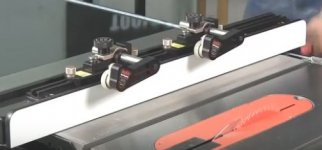Birdhunter
Member
- Joined
- Jun 16, 2012
- Messages
- 4,108
I have a set of JessEm roller guides on my SawStop table saw and my router table.
I am considering adding a third roller unit to the table saw JessEm track. I have one in front of the blade just a few inches back from the front of the fence. The second is in line with the blade.
I see stock drifting away from the fence near the back of the fence occasionally. I’ve checked the fence and it is parallel to both the saw blade and the saw’s two slots. The cut measures perfect even if I see the stock drifting away from the fence well behind the blade.
I would add the third roller guide about two thirds down the fence well behind the blade.
Any safety concerns? Bad idea?
I am considering adding a third roller unit to the table saw JessEm track. I have one in front of the blade just a few inches back from the front of the fence. The second is in line with the blade.
I see stock drifting away from the fence near the back of the fence occasionally. I’ve checked the fence and it is parallel to both the saw blade and the saw’s two slots. The cut measures perfect even if I see the stock drifting away from the fence well behind the blade.
I would add the third roller guide about two thirds down the fence well behind the blade.
Any safety concerns? Bad idea?


